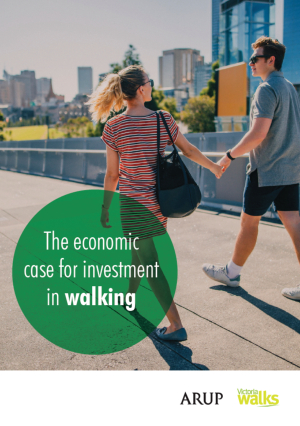The economic case for walking
Victoria Walks asked global consultancy firm Arup to look at the economic case for investment in walking, to help us understand why walking seems to fall through the cracks of government decision making and investment.
Their report The Economic Case for Investment in Walking outlines the benefits of walking, along with the role it plays in transport, recreation and health. The report then analyses how transport investment frameworks apply to walking.
Some notable findings from the report include:
- If half of short private vehicle trips (0-0.9 km) in Melbourne and Geelong were converted to walking, there would be 2.4 million fewer vehicle trips each week, with savings of $165 million each year.
- Walking already accounts for 1 in 6 of Melbourne’s weekday trips.
- Investing in walking infrastructure can provide a higher economic return than other transport projects such as rail and road. Evidence from 20 different studies suggested that the benefit cost ratio of walking interventions is 13:1 – $13 of benefit for every $1 of expenditure.
- The guidance used to capture the cost-benefits of potential walking investments is complex, lacks clarity, doesn’t distinguish between different types of walking and is dependent on inputting travel data that generally doesn’t exist for walking.
- Walking has been overlooked as a potential investment and underplayed in city-shaping projects. For example, most train trips start and end with walking, but the economic evaluation for projects such as Melbourne Metro have not included walking.
- Walking is also the most popular recreational activity, with over one million participants in Victoria. However government investment in sport and recreation tends to go to organised sport.
Recommendations to the state government from The Economic Case for Investment in Walking include:
- Increase investment in walking projects through a dedicated funding stream. It suggests a transition to 20% of the State transport budget being spent on non-motorised transport, as per UN recommendations.
- Adopt a target for increasing the proportion of short trips undertaken by walking.
- Establish a clear governance group responsible for the strategy, planning, investment, and reporting of walking projects.
- Develop a clear strategy and associated action plan for walking in Victoria.
- Clearly delineate investment in walking in both budgeting and annual reporting.
- Collect better data on walking both as a transport mode by itself and as a crucial element of multi-modal trips.
